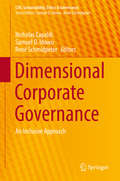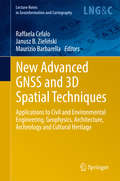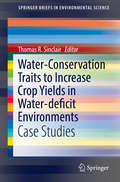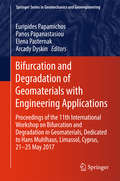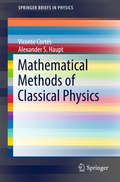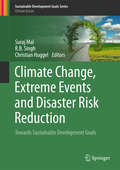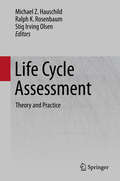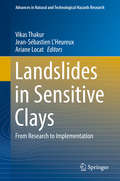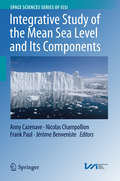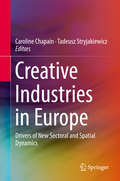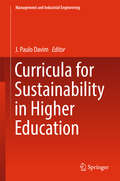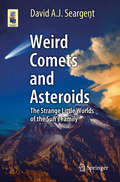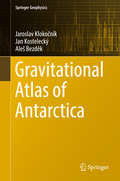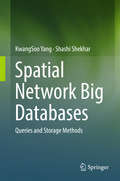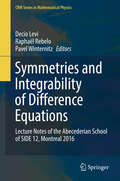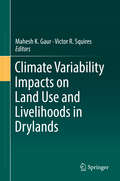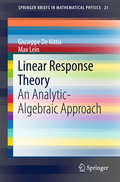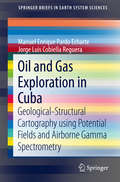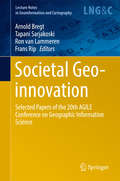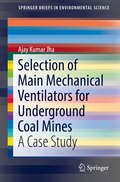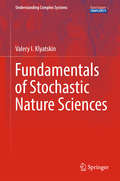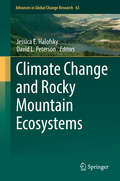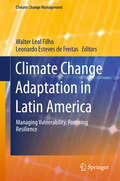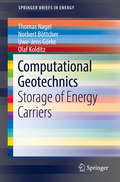- Table View
- List View
Dimensional Corporate Governance: An Inclusive Approach (CSR, Sustainability, Ethics & Governance)
by Nicholas Capaldi Samuel O. Idowu René SchmidpeterThis book explores different dimensions of the field of corporate governance and social responsibility. It discusses how business and society perceive and relate to CSR; how the field has continued to reshape modern corporate boardrooms in both the advanced and emerging economies; how CSR has transformed the manner in which modern corporate entities disclose the non-financial information aspect of their operations to the world at large; and the way in which sustainable development has continued to contribute to improving the quintuple bottom line - people, planet, prosperity, partnership and peace - of 21st century corporate entities. Further, the book also provides evidence of how these aspects of corporate social responsibility are depicted in different forms in eleven nations around the globe.
New Advanced GNSS and 3D Spatial Techniques: Applications to Civil and Environmental Engineering, Geophysics, Architecture, Archeology and Cultural Heritage (Lecture Notes in Geoinformation and Cartography)
by Raffaela Cefalo Janusz B. Zieliński Maurizio BarbarellaThis book provides the latest research on and applications of advanced GNSS (Global Navigation Satellite System) and 3D spatial techniques in the fields of Civil and Environmental Engineering, Geophysics, Architecture, Archaeology and Cultural Heritage. It offers an updated reference guide on the above-mentioned topics for undergraduate and graduate students, PhDs, researchers, professionals and practitioners alike.
Fundamentals of Tensor Calculus for Engineers with a Primer on Smooth Manifolds (Solid Mechanics and Its Applications #230)
by Uwe MühlichThis book presents the fundamentals of modern tensor calculus for students in engineering and applied physics, emphasizing those aspects that are crucial for applying tensor calculus safely in Euclidian space and for grasping the very essence of the smooth manifold concept.After introducing the subject, it provides a brief exposition on point set topology to familiarize readers with the subject, especially with those topics required in later chapters.It then describes the finite dimensional real vector space and its dual, focusing on the usefulness of the latter for encoding duality concepts in physics. Moreover, it introduces tensors as objects that encode linear mappings and discusses affine and Euclidean spaces. Tensor analysis is explored first in Euclidean space, starting from a generalization of the concept of differentiability and proceeding towards concepts such as directional derivative, covariant derivative and integration based on differential forms. The final chapter addresses the role of smooth manifolds in modeling spaces other than Euclidean space, particularly the concepts of smooth atlas and tangent space, which are crucial to understanding the topic. Two of the most important concepts, namely the tangent bundle and the Lie derivative, are subsequently worked out.
Water-Conservation Traits to Increase Crop Yields in Water-deficit Environments: Case Studies (SpringerBriefs in Environmental Science)
by Thomas R. SinclairThis volume explores specific approaches that have shown to result in crop yield increases. Research on the physiological understanding of these methods has led to the development of practical applications of plant breeding approaches to genetically improve crops to achieve higher yields. Authoritative entries from crop scientists shed new light on two water-conservation traits: one that is based on an initiation of the decrease in transpiration earlier in the soil drying cycle, and the second that is based on a sensitivity of transpiration rate under high atmospheric vapor pressure deficit that results in partial stomatal closure. Both these approaches involve partial stomatal closure under well-defined situations to decrease the rate of soil water loss. Readers will be able to analyze the circumstances under which a benefit is achieved as a result of the water-limitation trait; and key discussion points in the case studies presented will help answer questions such as what species, which environments, how often will yield be benefited for various crop species? Contributions also review the genetic variation for these two traits within each crop species and the physiological basis for the expression of these traits.
Bifurcation and Degradation of Geomaterials with Engineering Applications: Proceedings of the 11th International Workshop on Bifurcation and Degradation in Geomaterials dedicated to Hans Muhlhaus, Limassol, Cyprus, 21-25 May 2017 (Springer Series in Geomechanics and Geoengineering)
by Euripides Papamichos Panos Papanastasiou Elena Pasternak Arcady DyskinThis book contains the scientific contributions to the 11th International Workshop on Bifurcation and Degradation in Geomaterials (IWBDG) held in Limassol-Cyprus, May 21-25, 2017. The IWBDG series have grown in size and scope, since their inception 30 years ago in Germany, covering more and wider areas of geomaterials and geomechanics research including modern trends. The papers cover a wide range of topics including advances in instabilities, localized and diffuse failure, micromechanical, multiscale phenomena, multiphysics modeling and other related topics. This volume gathers a series of manuscript by brilliant international scholars who work on modern recent advances in experimental, theoretical and numerical methods. The theoretical and applied mechanics are linked successfully with engineering applications in traditional and in emerging fields, such as geomechanics for the energy and the environment. The quality of the contributed papers has benefited from the peer review process by expert referees. This book can be used as a useful reference for research students, academics and practicing engineers who are interested in the instability and degradation problems in geomaterials, geomechanics, geotechnical engineering and other related applications.
Mathematical Methods of Classical Physics (SpringerBriefs in Physics)
by Vicente Cortés Alexander S. HauptThis short primer, geared towards students with a strong interest in mathematically rigorous approaches, introduces the essentials of classical physics, briefly points out its place in the history of physics and its relation to modern physics, and explains what benefits can be gained from a mathematical perspective.As a starting point, Newtonian mechanics is introduced and its limitations are discussed. This leads to and motivates the study of different formulations of classical mechanics, such as Lagrangian and Hamiltonian mechanics, which are the subjects of later chapters.In the second part, a chapter on classical field theories introduces more advanced material. Numerous exercises are collected in the appendix.
Climate Change, Extreme Events and Disaster Risk Reduction: Towards Sustainable Development Goals (Sustainable Development Goals Series)
by Suraj Mal R. B. Singh Christian HuggelThis book discusses the science, causes, impacts and risk reduction strategies for climate change and disasters. It focuses on the use of traditional knowledge, new innovation and education to build a culture of safety and resilience at all levels in order to promote sustainable development goals in general and disaster risk reduction in particular.The global climate has changed substantially over the last century. There is strong evidence of global climate change in the form of increase in air and sea surface temperature, recession of glaciers, changes and shifting of climate regimes, increasing number of extreme events and sea levels changes. The increasing frequency of climate change induced disasters in particular is posing a threat to resilience, lives and livelihoods at global, regional and local levels. Major ecosystems of the world have experienced several climate induced disaster events in recent past.This book provides new insights into the occurrence and impacts of climatic extremes and strategies for disaster risk reduction. It includes studies on rainfall and temperature trends, floods and drought disasters, weather and climatic related disasters in mountains, changes in plant activities, risk assessment and responses in different ecosystems of the world. The book is particularly useful for environmental and disaster managers, researchers and graduate students, as well as policy makers.
Life Cycle Assessment: Theory and Practice (Lca Compendium - The Complete World Of Life Cycle Assessment Ser.)
by Michael Z. Hauschild Ralph K. Rosenbaum Stig Irving OlsenThis book is a uniquely pedagogical while still comprehensive state-of-the-art description of LCA-methodology and its broad range of applications. The five parts of the book conveniently provide: I) the history and context of Life Cycle Assessment (LCA) with its central role as quantitative and scientifically-based tool supporting society’s transitioning towards a sustainable economy; II) all there is to know about LCA methodology illustrated by a red-thread example which evolves as the reader advances; III) a wealth of information on a broad range of LCA applications with dedicated chapters on policy development, prospective LCA, life cycle management, waste, energy, construction and building, nanotechnology, agrifood, transport, and LCA-related concepts such as footprinting, ecolabelling,design for environment, and cradle to cradle. IV) A cookbook giving the reader recipes for all the concrete actions needed to perform an LCA. V) An appendix with an LCA report template, a full example LCA report serving as inspiration for students who write their first LCA report, and a more detailed overview of existing LCIA methods and their similarities and differences.
Landslides in Sensitive Clays: From Research to Implementation (Advances in Natural and Technological Hazards Research #46)
by Vikas Thakur Jean-Sébastien L'Heureux Ariane LocatThis book gathers the most recent scientific research on the geological, geotechnical and geophysical aspects of slope failure in sensitive clays. Gathering contributions by international experts, it focuses on understanding the complete and practical spectrum of challenges presented by landslides in such complex materials. Based on sound and validated research results, the book also presents several recommendations that could be implemented in the guidelines or code-of-practice. These recommendations cover topics including the characterization and behavior of sensitive clays; the pre-failure, failure and post-failure stages of sensitive clays; mapping and identification methods; climate change; hazard assessment; and risk management. Sensitive clays are known for their potential for causing large landslides, which pose a serious risk to human lives, infrastructure, and surrounding ecosystems within their reach. This has been demonstrated by the recent catastrophic landslides in e.g. Sørum (2016), Skjeggestad (2015), Statland (2014), Byneset (2012), St-Jude (2010), Lyngen (2010) and Kattmarka (2009). The 2015 collapse of the Skjeggestad Bridge in Norway – which was due to a landslide in sensitive clay – alone costs millions of dollars in repairs. Recently, efforts are being made to increase society’s ability to cope with such landslide hazards. Geoscientists are now expected to provide input to the agencies responsible for landslide-risk preparedness. In other words, geoscientists’ role is not only to act as technologists to establish new theories, but also to go the extra mile to implement them in practice, so as to find meaningful solutions to geotechnical problems.
Integrative Study of the Mean Sea Level and Its Components (Space Sciences Series of ISSI #58)
by Anny Cazenave Nicolas Champollion Frank Paul Jérôme BenvenisteThis volume presents the most recent results of global mean sea level variations over the satellite altimetry era (starting in the early 1990s) and associated contributions, such as glaciers and ice sheets mass loss, ocean thermal expansion, and land water storage changes. Sea level is one of the best indicators of global climate changes as it integrates the response of several components of the climate system to external forcing factors (including anthropogenic forcing) and internal climate variability. Providing long, accurate records of the sea level at global and regional scales and of the various components causing sea level changes is of crucial importance to improve our understanding of climate processes at work and to validate the climate models used for future projections. The Climate Change Initiative project of the European Space Agency has provided a first attempt to produce consistent and continuous space-based records for several climate parameters observable from space, among them sea level. This book presents current knowledge of the sea level budget over the altimetry era and 20th century.Previously published in Surveys in Geophysics, Volume 38, Issue 1, 2017
Creative Industries in Europe: Drivers of New Sectoral and Spatial Dynamics
by Caroline Chapain Tadeusz StryjakiewiczThis book demonstrates how the creative industries are driving new sectoral and spatial dynamics in European cities, regions, and countries, and how these may be influenced by international and global dynamics. It takes a purposeful geographical approach to the study of the creative industries across various Western, Central and Eastern European contexts since the 2008-2009 recession. Despite the growing research looking at the development of the creative industries in the last 15 years, there are still gaps in the coverage of what is happening in Central and Eastern Europe compared to Western Europe. This book addresses these gaps in two parts focusing on particular geographical scales and creative processes: local interplay between sector and space and the role of the creative industries in regional and national economies after the crisis. The book presents original analyses of the post-crisis environment, and novel data on topics such as the role of institutions in the regulation of the fashion industry in global cities, the impact of clustering on film innovation, location patterns of art galleries, regional specialisations and paths of professional carriers in creative industries.
Curricula for Sustainability in Higher Education (Management and Industrial Engineering)
by J. Paulo DavimThis books presents the curricula necessary for sustainability in higher education. It shows how the learning process is transforming in order to promote sustainability. It prepares administrators, teachers and students to diffuse the development in the field, showing a curricula based on three interconnected pillars: the environment, the economic and the social aspects. It contains 8 chapters introducing research advances in the field.
Weird Comets and Asteroids: The Strange Little Worlds of the Sun's Family (Astronomers' Universe)
by David A. SeargentThis book concentrates on some of the odd aspects of comets and asteroids. Strange behavior of comets, such as outbursts and schisms, and how asteroids can temporally act as comets are discussed, together with the possible threat of Centaurs-class objects like the Taurid complex.Recent years have seen the distinction between comets and asteroids become less prominent. Comets in "asteroid" orbits and vice versa have become almost commonplace and a clearer view of the role of small bodies in the formation of the Solar System and their effect on Earth has become apparent. Seargent covers this development in detail by including new data and information from space probes.
Gravitational Atlas of Antarctica (Springer Geophysics)
by Jaroslav Klokočník Jan Kostelecký Aleš BezděkThis book presents maps of Antarctica, exploring various aspects of its disturbing geopotential and based on the EIGEN 6C4 model, arguably the best gravitational field model currently available. It also provides the latest data on Antarctica’s bedrock topography according to Bedmap 2. In an extensive series of segment maps the book highlights (i) a gravity anomaly (disturbance), (ii) the Marussi tensor of the second derivatives of the disturbing geopotential, (iii) invariants and their ratios, (iv) the strike angle, and (v) virtual deformations. Due to their various degrees of sensitivity to the density contrasts of causative bodies under the Earth’s surface, these maps provide many details that have a range of potential geo-applications. They guide the reader through the entire continent, in segments divided by 30 degrees of longitude, and through geodetic latitudes of between 60 and 90 degrees south. Each segment is complemented by detailed zoom-in maps for selected localities of special interest.
Spatial Network Big Databases: Queries and Storage Methods
by KwangSoo Yang Shashi ShekharThis book provides a collection of concepts, algorithms, and techniques that effectively harness the power of Spatial Network Big Data. Reading this book is a first step towards understanding the immense challenges and novel applications of SNBD database systems. This book explores these challenges via investigating scalable graph-based query processing strategies and I/O efficient storage and access methods. This book will be of benefit to academics, researchers, engineers with a particular interest in network database models, network query processing, and physical storage models.
Symmetries and Integrability of Difference Equations: Lecture Notes of the Abecederian School of SIDE 12, Montreal 2016 (CRM Series in Mathematical Physics #381)
by Decio Levi Raphaël Rebelo Pavel WinternitzThis book shows how Lie group and integrability techniques, originally developed for differential equations, have been adapted to the case of difference equations. Difference equations are playing an increasingly important role in the natural sciences. Indeed, many phenomena are inherently discrete and thus naturally described by difference equations. More fundamentally, in subatomic physics, space-time may actually be discrete. Differential equations would then just be approximations of more basic discrete ones. Moreover, when using differential equations to analyze continuous processes, it is often necessary to resort to numerical methods. This always involves a discretization of the differential equations involved, thus replacing them by difference ones. Each of the nine peer-reviewed chapters in this volume serves as a self-contained treatment of a topic, containing introductory material as well as the latest research results and exercises. Each chapter is presented by one or more early career researchers in the specific field of their expertise and, in turn, written for early career researchers. As a survey of the current state of the art, this book will serve as a valuable reference and is particularly well suited as an introduction to the field of symmetries and integrability of difference equations. Therefore, the book will be welcomed by advanced undergraduate and graduate students as well as by more advanced researchers.
Climate Variability Impacts on Land Use and Livelihoods in Drylands
by Mahesh K. Gaur Victor R. SquiresThis edited volume is devoted to the examination of the implications of the inevitable changes wrought by global change on the welfare and livelihoods of tens of millions of people who live in dryland regions. Global change is more than just climate change and the ramifications of changing trade patterns (geopolitical and economic aspects), the shift to the market economy, demographic factors (population growth, urbanization and re-settlement), receive attention here. Land use change specialists, policy makers and natural resource management agencies will find the book very useful.Chapters focus on examples that are drawn from a number of sources including previously unpublished studies on the impact of climate change, markets and economics on pastoralist and dryland farming households. The key focus is to provide readers with insights into the real world implications of change (including an analysis of the drivers of change) on these vulnerable groups within dryland societies. The role of humans as agents of these changes is canvassed. A regional analysis of the world's drylands is also performed including those in Australia, Argentina, India, North America, China, North Africa, Central Asia and Southern Africa.
Linear Response Theory: An Analytic-Algebraic Approach (SpringerBriefs in Mathematical Physics #21)
by Giuseppe De Nittis Max LeinThis book presents a modern and systematic approach to Linear Response Theory (LRT) by combining analytic and algebraic ideas. LRT is a tool to study systems that are driven out of equilibrium by external perturbations. In particular the reader is provided with a new and robust tool to implement LRT for a wide array of systems. The proposed formalism in fact applies to periodic and random systems in the discrete and the continuum. After a short introduction describing the structure of the book, its aim and motivation, the basic elements of the theory are presented in chapter 2. The mathematical framework of the theory is outlined in chapters 3–5: the relevant von Neumann algebras, noncommutative $L^p$- and Sobolev spaces are introduced; their construction is then made explicit for common physical systems; the notion of isopectral perturbations and the associated dynamics are studied. Chapter 6 is dedicated to the main results, proofs of the Kubo and Kubo-Streda formulas. The book closes with a chapter about possible future developments and applications of the theory to periodic light conductors. The book addresses a wide audience of mathematical physicists, focusing on the conceptual aspects rather than technical details and making algebraic methods accessible to analysts.
Oil and Gas Exploration in Cuba: Geological-Structural Cartography using Potential Fields and Airborne Gamma Spectrometry (SpringerBriefs in Earth System Sciences)
by Manuel Enrique Pardo Echarte Jorge Luis Cobiella RegueraA summary of the results achieved in the geological-structural mapping, by potential fields and airborne gamma spectrometry data, of the units of igneous and metamorphic rocks in the western regions (Havana-Matanzas), central (Cienfuegos, Villa Clara-Sancti Spiritus) and central-eastern (Camagüey-Las Tunas-Holguín) of Cuba is presented. In addition, the structural- tectonic regionalization with hydrocarbon exploration purposes, focusing mapping of possible new oil-gas targets in the regions of Land Blocks 9, 23 and 17-18 are detailed in this volume. In certain case study locations (Majaguillar, North Motembo, Guamutas and Maniabón) reconnaissance work by a profile of Redox Complex (complex of unconventional geophysical-geochemical exploration techniques) was performed with positive results. In an attempt to contribute to the geological-structural mapping of the metamorphic massif Isla de la Juventud, with emphasis on acid magmatism, the gravi-magnetometric data is used. According to the results, the presumed post metamorphic granitic bodies of low density are located, mainly, in the central and southwestern part of the massif. The granitic bodies apparently were introduced through the system of longitudinal faults (syn metamorphic) and transverse (post metamorphic) at the end of the process multyfolding and metamorphism of the massif sequences, taking a leading role the deep longitudinal fracture zones of sublatitudinal direction in the central and southern part of the massif. On the map of the magnetic field vertical derivative the anomalies, basically, reflected the direction and limits of the folded tectonic structure, the development area of volcanogenic rocks, the presumed development zones of migmatitic rocks and tectonised rocks in North and center of the massif, respectively, and the prevailing direction of the main tectonic dislocations.
Societal Geo-innovation: Selected papers of the 20th AGILE conference on Geographic Information Science (Lecture Notes in Geoinformation and Cartography)
by Arnold Bregt Tapani Sarjakoski Ron Van Lammeren Frans RipThis book contains the full research papers presented at the 20th AGILE Conference on Geographic Information Science, held in 2017 at Wageningen University & Research in Wageningen, the Netherlands. The selected contributions show trends in the domain of geographic information science directed to spatio-temporal perception and spatio-temporal analysis. For that reason the book is also of interest to professionals and researchers in fields outside geographic information science, in which the application of geoinformation could be instrumental in sparking societal innovation.
Selection of Main Mechanical Ventilators for Underground Coal Mines: A Case Study (SpringerBriefs in Environmental Science)
by Ajay Kumar JhaThis book provides information on proper underground mine ventilation in order to detail its importance in maintaining safe, productive, healthy and effective underground environments at all times for employees. The text covers correct design, implementation and maintenance of mine ventilation through suitable fan installation, and keeps in mind the economic requirements of undertaking safe procedures and implementations to ensure that ventilation is optimal. Through three main goals, the book addresses the need for proper fan ventilation in the potentially hazardous conditions of an underground mine. The first goal is to summarize and update the technical information on the strategic importance of selecting suitable techno-commercial main mechanical ventilators for a coal mine. The second goal is to provide a user friendly computer program to help any practicing engineers, mine operators, regulators and researchers in choosing the main mechanical ventilators. Factors in this selection process include environmental requirements, regulatory conditions, occupational health related issues, and cost. The third goal is to provide applications for computer programs meant to determine proper selection and implementation of the main mechanical ventilators. The text is geared towards teachers, researchers, policy makers, environmental organizations and mine operators who wish to teach about or implement the best possible ventilation systems for the health and safety of mine workers.
Fundamentals of Stochastic Nature Sciences (Understanding Complex Systems)
by Valery I. KlyatskinThis book addresses the processes of stochastic structure formation in two-dimensional geophysical fluid dynamics based on statistical analysis of Gaussian random fields, as well as stochastic structure formation in dynamic systems with parametric excitation of positive random fields f(r,t) described by partial differential equations. Further, the book considers two examples of stochastic structure formation in dynamic systems with parametric excitation in the presence of Gaussian pumping. In dynamic systems with parametric excitation in space and time, this type of structure formation either happens – or doesn’t! However, if it occurs in space, then this almost always happens (exponentially quickly) in individual realizations with a unit probability.In the case considered, clustering of the field f(r,t) of any nature is a general feature of dynamic fields, and one may claim that structure formation is the Law of Nature for arbitrary random fields of such type. The study clarifies the conditions under which such structure formation takes place. To make the content more accessible, these conditions are described at a comparatively elementary mathematical level by employing ideas from statistical topography.
Climate Change and Rocky Mountain Ecosystems (Advances in Global Change Research #63)
by Jessica Halofsky David L. PetersonThis book is the result of a team of approximately 100 scientists and resource managers who worked together for two years to understand the effects of climatic variability and change on water resources, fisheries, forest vegetation, non-forest vegetation, wildlife, recreation, cultural resources and ecosystem services. Adaptation options, both strategic and tactical, were developed for each resource area. This information is now being applied in the northern rocky Mountains to ensure long-term sustainability in resource conditions.The volume chapters provide a technical assessment of the effects of climatic variability and change on natural and cultural resources, based on best available science, including new analyses obtained through modeling and synthesis of existing data. Each chapter also contains a summary of adaptation strategies (general) and tactics (on-the-ground actions) that have been developed by science-management teams.
Climate Change Adaptation in Latin America: Managing Vulnerability, Fostering Resilience (Climate Change Management)
by Walter Leal Filho Leonardo Esteves de FreitasThis book showcases experiences from research, field projects and best practice in climate change adaptation in countries in the Latin American region, focusing on managing vulnerability and fostering resilience. It includes a selection of papers presented at a specialist symposium on climate change adaptation held in Rio de Janeiro, Brazil in November 2016.Consistent with the need for more cross-sectoral interaction among the various stakeholders working in the field of climate change adaptation in Latin America, the book documents and disseminates the wealth of experiences in the region. It is divided into two main parts: Part 1 addresses the current and future impacts of climate change on fauna, flora and landscapes, while Part 2 is concerned with the socio-economic aspects of climate change adaptation, analyzing some of the main problems prevailing in this vulnerable region and examining ways to address them.
Computational Geotechnics: Storage of Energy Carriers (SpringerBriefs in Energy)
by Thomas Nagel Norbert Böttcher Uwe-Jens Görke Olaf KolditzIn this book, effective computational methods to facilitate those pivotal simulations using open-source software are introduced and discussed with a special focus on the coupled thermo-mechanical behavior of the rock salt. A cohesive coverage of applying geotechnical modeling to the subsurface storage of hydrogen produced from renewable energy sources is accompanied by specific, reproducible example simulations to provide the reader with direct access to this fascinating and important field. Energy carriers such as natural gas, hydrogen, oil, and even compressed air can be stored in subsurface geological formations such as depleted oil or gas reservoirs, aquifers, and caverns in salt rock. Many challenges have arisen in the design, safety and environmental impact assessment of such systems, not the least of which is that large-scale experimentation is not a feasible option. Therefore, simulation techniques are central to the design and risk assessment of these and similar geotechnical facilities.
